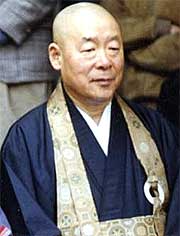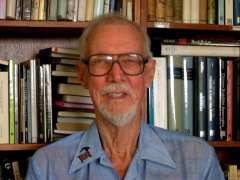SelfDefinition.Org
The Zen Master in America
Dressing the Donkey with Bells and Scarves
by Stuart Lachs

5. Soen Nakagawa Roshi and Eido Shimano Roshi
Text
"Our way is to see what we are doing, moment after moment." [83]

Eido Shimano Roshi (1932-2018)
Like both Baker and Suzuki, Soen Nakagawa [see part 4] was a person whose history and everyday life we know much about, certainly more than we know about the Zen masters of old. I will show that the picture painted of Soen Nakagawa by Suzuki is more fantasy than reality. I will also show that Soen's prime disciple, Eido Shimano roshi, [Wikipedia] is also far from the idealized picture of the roshi commonly promulgated in Zen literature.
Shimano received Dharma transmission from Soen in 1972 in a dramatic public ceremony. Eido Shimano had a long history of sexual and financial scandal beginning in Hawaii in the early 1960's while staying with Robert Aitken. [84] Within a couple weeks of each other, two women in Aitken's group were hospitalized after experiencing mental breakdowns. Concerned, Aitken consulted with their psychiatrist who suggested that he volunteer at their mental health ward. After a time, Aitken asked Shimano to come along. Very soon the psychiatrist called Aitken aside and said the head nurse on the ward had accused Shimano of being at the center of the cases of these two women who claimed to have suffered from Shimano's "depredation." [85] The head nurse also believed that Shimano was volunteering so that he could prey on other women. Aitken was "stunned" but followed through with an investigation.

Robert Aitken (2017-2010) [Wikipedia]
When he was certain the accusations were true, he flew to Japan to consult with Soen Nakagawa roshi. Soen listened carefully, but Aitken sensed he "did not take the news very seriously." Aitken and Soen then went to tell Yasutani roshi [86] the news but "he was even less concerned." Aitken returned to Hawaii, without having accomplished anything, to find that Shimano knew of his trip. Shortly thereafter, Shimano "felt obliged to move to NYC." [87] A wife was found for him, presumably to absorb his misdirected amorous passions. But Soen's simplistic solution was not effective. As Baker referred to, in 1982, at a SFZC Board of Trustee meeting, Shimano continued to be sexually involved with his students, which over time led to periodic scandals. One of the worst was in 1976, when a good part of the membership either resigned or was thrown out by Shimano, by then a Zen master himself. The only possible visible sign that Soen disapproved of Shimano's behavior was his failure to attend the opening of Shimano's new American monastery, Daibosatsu, on Independence Day, July 4, 1976. Like his teacher Soen roshi, Shimano had a flair for the dramatic.
For the next seven years or so scandals surrounding Shimano erupted periodically. Soen again did nothing visible to stem the tide. Then, in 1983, Soen went to NYC where some of Shimano's oldest and most loyal students asked Soen to issue a public statement [88] to qualify Shimano's legitimacy, transmission, and title as roshi and abbot. Soen indicated that he would honor their request, but unfortunately, once again, he did nothing visible. He returned to Japan without a public word mitigating Shimano's authority. Acts of omission can speak as loudly and injuriously as those of commission. Soen's silence does, in fact, speak.
Eido roshi, as Shimano was known by then, though known to have had many sexual affairs with his female students, to have acted with unbridled self-interest, and to have broken apart his sangha [89] a number of times, causing much pain to many, will appear in the orthodox Rinzai lineage charts as an unblemished, enlightened Zen master and as an authentic connection to Bodhidharma and the historical Buddha. Soen, in March of 1984, died alone at his home monastery, Ryutaku-ji. Even in his death, Soen lends legitimacy to Shimano as he allowed at least part of his ashes to be buried at Shimano's monastery, Daibosatsu. [90]
Losing face is an extremely important matter in Japanese culture, one to be avoided at all costs. As long as he was in a Zen context, Soen was iconoclastic and performed well in the public role of Rinzai roshi. But, when confronted with a real and difficult, public and embarrassing problem, it would appear that he was as constrained by his cultural background as any other ordinary or "usual" Japanese. He did not make a public statement about his heir Eido roshi, nor did he do anything that led to questioning of his own authority, insight or the ideological system of which he was a prime representative. In a word, he acted like any ordinary, conservative, well-socialized Japanese. In this manner, he did not serve well the American disciples who so worshipped him. He returned to Japan, leaving many of his American followers disappointed while leaving his dharma heir, Eido Shimano, with unquestioned authority and legitimacy. [91] Shimano could rightfully claim that he was the sole heir of Soen Nakagawa living in America. In the process, this Zen roshi, Eido Shimano, tarnished by a number of scandals, was allowed to continue causing trouble for new, unsuspecting Western students.
In an act unprecedented in American Zen, Robert Aitken roshi and seven other American Zen teachers wrote a letter to the President of the Board of Directors of the Zen Studies Society, Shimano's organization. The letter dated August 9, 1995, wrote about interviewing former students of Shimano over a period of three decades and hearing the "same depressing story" about Shimano's "sexual misconduct and abuse." They added that these relationships are "exploitative and extremely damaging to his victims." They suggested Shimano either resign or enter a program to "help him with his harmful predilections," noting that completing a program does not guarantee a cure. There is no evidence that Shimano did or did not enter such a program, but we do know that he did not resign. [92] [* Update: Shimano finally resigned in 2010. See Boston Globe, Feb. 27, 2018: "Eido Shimano, Buddhist Leader Who Resigned in Scandal, Dies at 85." Obituary ]
Notes, part 5
[83] Crooked Cucumber, p. 371.
[84] The information about the Shimano episode in Hawaii is the result of a private correspondence between Aitken roshi and the author. (*)
[* Also see voluminous archives at The Shimano Archive (caution, you may be prompted to accept or block download of 2 nonessential video files when accessing this page, total 25 megs): https://shimanoarchive.com ]
Robert Aitken was given permission to teach in 1974 by Yasutani's heir, Yamada roshi and received Dharma-transmission from him in 1985 making him an independent Zen master. He later broke with Yasutani's Sanbokyodan sect because of what amounts to Japanese chauvinism. See Sharf, Robert, "Sanbokyodan Zen and the Way of New Religions," Japanese Journal of Religious Studies22 (1995) 450–451. Aitken was also disturbed because his Dharma transmitted heirs would need to be examined by Japanese roshi with whom they had no prior relationship, one of whom was junior to him. This raises a number of questions about the meaning and trustworthiness of Dharma transmission.
[85] This is the word that Aitken used in our private correspondence. [Also see "From Zen Buddhism to Preying on Vulnerable Women" (2013) at Atlantic.Com ]
[86] [return to chapter 4, note 71] Yasutani was founder of the Sanbokyodan sect of Zen. [Wikipedia] Though small in Japan, it is perhaps the largest Zen sect in the West.
[87] Aitken, Robert, Original Dwelling Place, Counterpoint, 1996, p. 21. See pp. 15–22 where Aitken discusses his relationship with Soen and gives more information about Shimano. He mentions that the other monks at Ryutaku-ji Monastery "seemed to have doubts about Shimano" and that Shimano was not accepted by them. Aitken says that his relationship with Soen fell apart after mentioning Shimano's trouble with women in Hawaii. Aitken felt that Soen blamed him for Shimano's trouble in Hawaii. Aitken also attempts to explain Soen's loyalty to Shimano which was perplexing to westerners. Aitken believes that in his later years Soen felt betrayed by Shimano and that his "life and commitments" were "unfulfilled."
[88] The author has copies of letters circulated among students and ex-students discussing the situation.
[89] Sangha historically meant ordained monks and nuns. In American Zen, the term has become democratized and is used to refer to the group of practitioners, both lay and ordained, at a given Zen center. Chinese Zen groups stick to the historic meaning more than Japanese Zen groups.
[90] Buddhadharma, Spring 2006, p. 20.
[91] American students, including Aitken, may have expected Soen to be something he was not. Soen viewed the world through a Japanese cultural lens, something different from the American lens. It may have been unrealistic on the part of Americans to expect Soen to be open about or to question a Dharma heir, much less any aspect of the Zen system he represented. Cultural differences are almost never mentioned in terms of a Zen master. Of course, doing so opens a can of worms: when is the master expressing a cultural view and when is he expressing pure teaching? Although Zen spokespeople like to abstract Zen out of culture, time, and place, in actuality, it is always embedded in and speaks through a culture. Steven Katz has edited three books that discuss, among other ideas, cultural aspects of mysticism. See Mysticism and Language, Oxford University Press, 1992, Mysticism and Religious Experience, Oxford University Press, 1983, and Mysticism and Philosophical Analysis, Oxford University Press, 1978.
[92] The author has a copy of this letter. The letter is unprecedented because Zen teachers are extremely hesitant to interfere with or to admonish another teacher, especially so if the teacher is from another Zen sect or lineage. Here these teachers are suggesting a teacher resign or to seek psychological help. Though not explicitly mentioning it, there is a definite westernization taking place here, as they do not suggest "further practice" to correct the problem, but rather, psychological assistance as a possible help.